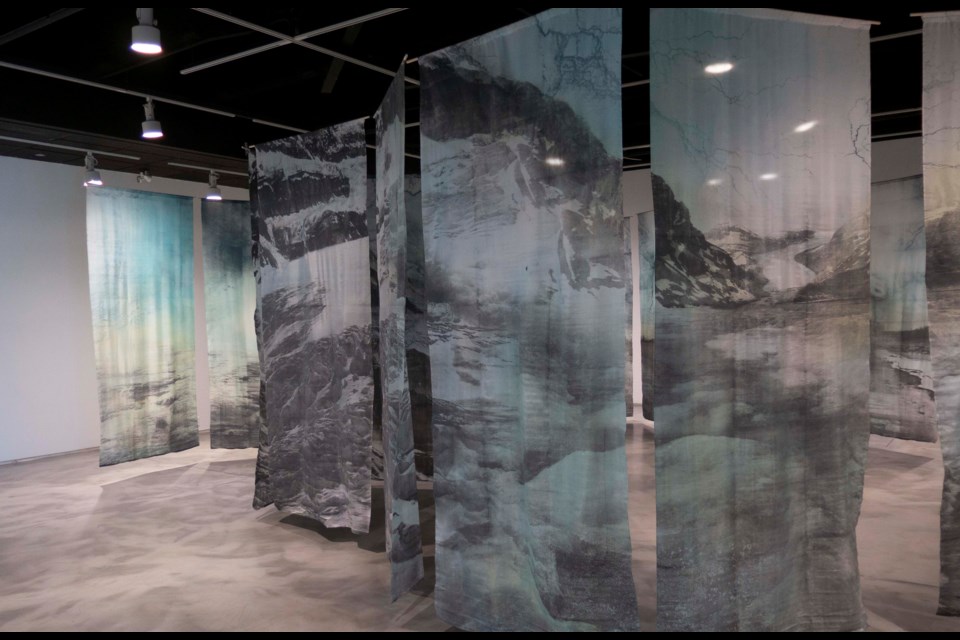There's something about water that completely mesmerizes.
We are captivated watching everything from rain droplets and snowflakes tumbling from the sky to meandering streams rippling with sunlight.
In most cultures, water is sacred. Judging by the number of fountains, aquatic paintings, photography, films, songs, pottery and digital installations flooding the market, art is how we pay homage to this essence of life.
Kelsey Stephenson, an instructor at the University of Alberta’s art and design department, is exhibiting her vision of Alberta’s waterways through Connected Currents. It is currently on display at the Art Gallery of St. Albert (AGSA) until April 27.
Stephenson is fascinated with water as a subject material because, “water is very changeable. It’s fluid. It’s solid. It’s tireless, and it changes over time,” she said.
The Edmonton-based visual artist’s passion for nature developed as a child during family road trips across the province. Her father was a civil engineer with an interest in geology. He shared his knowledge of how mountains, water and soil interact. Through his teachings, she discovered how the Rocky Mountains, glaciers and rivers shaped the land and our Canadian identity.
Connected Currents is essentially three separate projects that trace water’s passage as it flows across Alberta. Completed in Stephenson’s signature style, it is best described as big, bold and breathtaking.
Flux, a series of 22 breezy silk panels hand-printed from photographs she captured during several years' worth of mountainous treks, is suspended from the main gallery’s ceiling. The panels range from Athabasca Glacier, Crowfoot Glacier, and the Saskatchewan Glacier that feeds our river, to Bow Glacier Falls, Athabasca Falls and Johnson Canyon.
Each panel is about three metres tall and one metre wide. Even as the delicate silk panels contrast sharply with harsh mountainous glaciers, there is a subtle but strong theme that sticks out — the effects of climate change.
“You see the impact on glaciers and the natural spaces, especially with the weird winter we’ve had. If you know what to look for, you see a big change happening, and art has a big role to play,” Stephenson said.
The exhibition’s second work, Currents, is also a massive installation, covering one entire wall of the main gallery. Hundreds of individual panels using screen printing and cyanotype techniques are strung together to create an 11-metre-wide image of the sprawling Saskatchewan River.
High on the riverbanks is the Edmonton skyline, a mashup of an elegant Alberta legislature on the west, and oil refineries on the east. The installation displays the remarkable vastness of one of Alberta’s major waterways.
The third portion of the exhibition is a series of individual works that reconnect locations separated by time.
“Stephenson merges archival photographs from land surveys and early marketing brochures with the same view of the landscape today. Delicate and ghostly, these works drive home the dramatic changes that have taken place over the last century,” writes Emily Baker, AGSA curator, in a media release.
Connected Currents explores Alberta’s geological past, present and future. Stephenson hopes her art will inspire others to become more positive in appreciating the effects of climate change, and finding solutions so desperately needed.
A stickler for detail, Stephenson has also added nature sounds — waterfalls, birds, frogs and crackling ice — she recorded at different sites. Instead of strictly passive viewing, the recordings provide a deeper immersive experience.
AGSA offers an in-person tour on March 30 at noon, or a virtual tour on April 5 at 12 p.m. on Facebook Live. An artist talk and reception is on April 6 from 6:30 to 8:30 p.m. Registration is via the gallery’s exhibition page.



